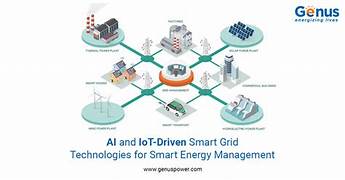AI in Energy Grid Optimization and Load Balancing
The rapid increase in global energy demand, coupled with the transition to renewable energy sources, has brought significant challenges to managing modern power grids. Traditional energy grid management methods often struggle with inefficiencies, unpredictable supply from renewable sources, and the growing complexity of energy distribution systems. In response, artificial intelligence (AI) has emerged as a transformative technology for optimizing energy grids and balancing loads, offering innovative solutions for a cleaner, more efficient, and reliable energy future.
This article explores how AI is revolutionizing energy grid optimization and load balancing, its applications, benefits, challenges, and the future it promises for the energy sector.
The Need for AI in Energy Grid Management
Power grids are complex systems that require continuous monitoring and control to ensure stable and efficient operation. The integration of renewable energy sources, such as solar and wind, has added another layer of complexity due to their intermittent nature. Some key challenges in grid management include:
- Fluctuating Energy Demand: Matching energy supply with demand is critical to avoid blackouts or overproduction.
- Integration of Renewables: Managing the variability of renewable energy sources while maintaining grid stability is a major challenge.
- Aging Infrastructure: Many grids operate on outdated infrastructure that struggles to accommodate modern energy needs.
- Energy Losses: Inefficient distribution systems result in significant energy losses during transmission and distribution.
- Real-Time Decision Making: Grids require instant decision-making capabilities to respond to unexpected events, such as equipment failures or demand surges.
AI technologies address these challenges by enabling real-time analysis, predictive insights, and automated decision-making to optimize grid performance.
How AI Optimizes Energy Grids
AI technologies utilize advanced algorithms, machine learning (ML), and data analytics to enhance various aspects of grid management. Here are some key ways AI contributes to energy grid optimization:
1. Demand Forecasting
AI models analyze historical and real-time data to predict energy consumption patterns accurately. This helps grid operators anticipate demand spikes or lulls, ensuring efficient energy distribution.
- Example: AI can forecast peak energy usage during heatwaves, enabling utilities to prepare additional energy reserves in advance.
2. Renewable Energy Integration
AI helps manage the variability of renewable energy sources by predicting their output based on factors like weather conditions, sunlight, and wind speeds. These predictions enable better planning and integration of renewable energy into the grid.
- Example: Wind turbine output can be predicted using AI, allowing operators to balance wind energy with other power sources during low-wind periods.
3. Load Balancing
AI optimizes load distribution by analyzing grid data and dynamically adjusting power flow. It ensures that energy is distributed evenly across the grid, preventing overloading of specific areas.
- Example: During high-demand periods, AI can redirect excess energy from low-demand regions to high-demand areas in real time.
4. Fault Detection and Predictive Maintenance
AI detects anomalies in grid performance, such as voltage fluctuations or equipment failures, before they escalate into significant problems. Predictive maintenance minimizes downtime and reduces repair costs.
- Example: AI systems can identify failing transformers and alert operators to replace them before they cause outages.
5. Energy Storage Management
AI optimizes the use of energy storage systems, such as batteries, by determining when to store excess energy and when to release it. This ensures a consistent energy supply even during peak demand or low renewable output.
- Example: AI can manage battery storage to release stored solar energy during nighttime hours, maintaining grid stability.
6. Grid Decentralization
With the rise of distributed energy resources (DERs) like rooftop solar panels and electric vehicles, AI enables decentralized grid management. It coordinates the operation of multiple small energy sources to function as a unified system.
- Example: AI can manage energy contributions from residential solar panels, optimizing their integration into the grid.
Applications of AI in Energy Grid Optimization
1. Smart Grid Management
AI-powered smart grids monitor and control energy flows in real time, enhancing grid efficiency and reliability. They can respond dynamically to changes in demand and supply, minimizing disruptions.
2. Virtual Power Plants (VPPs)
AI enables the creation of VPPs, which aggregate energy from distributed sources like solar panels, wind turbines, and batteries to act as a single power plant. This approach enhances grid flexibility and resilience.
3. Real-Time Energy Trading
AI facilitates real-time energy trading in deregulated markets by predicting price fluctuations and matching supply with demand. This benefits both utility companies and consumers.
4. Electric Vehicle (EV) Integration
AI helps integrate EVs into the grid by managing their charging schedules and using them as mobile energy storage units. This reduces strain on the grid during peak hours.
- Example: AI can schedule EV charging during low-demand periods and use their batteries to supply power back to the grid during peak demand.
5. Smart Meter Analytics
AI analyzes data from smart meters to provide insights into energy consumption patterns, enabling personalized energy-saving recommendations for consumers.
6. Disaster Response and Recovery
AI aids in disaster preparedness by predicting the impact of events like storms on grid infrastructure. It also supports faster recovery by prioritizing repair efforts in critical areas.
Benefits of AI in Energy Grid Management
1. Increased Efficiency
AI ensures optimal energy distribution, reducing losses and maximizing the utilization of resources.
2. Enhanced Reliability
By predicting and preventing outages, AI improves grid reliability and minimizes disruptions.
3. Cost Savings
Automated load balancing and predictive maintenance lower operational costs for utilities and reduce electricity bills for consumers.
4. Environmental Benefits
Efficient integration of renewable energy and reduced energy waste contribute to lower greenhouse gas emissions.
5. Scalability
AI systems can adapt to the growing complexity of grids as more renewable sources and distributed resources are added.
6. Improved Customer Experience
AI-powered tools provide consumers with insights into their energy usage and offer tailored recommendations to save energy and reduce costs.
Challenges of AI Implementation in Energy Grids
1. High Initial Investment
The deployment of AI systems requires significant upfront costs for infrastructure, sensors, and software development.
2. Data Privacy and Security
Collecting and analyzing large volumes of grid data raises concerns about data privacy and cybersecurity.
3. Integration with Legacy Systems
Many energy grids rely on outdated infrastructure that may not be compatible with modern AI technologies.
4. Skill Gap
Implementing and maintaining AI systems require specialized skills that may not be readily available in the workforce.
5. Regulatory Hurdles
The adoption of AI in grid management may face regulatory challenges, particularly in regions with strict oversight of energy systems.
Case Studies: AI in Action
1. National Grid (UK)
The National Grid uses AI to predict energy demand and optimize the integration of renewable energy sources. This has helped the UK reduce reliance on fossil fuels and lower energy costs.
2. Xcel Energy (USA)
Xcel Energy employs AI for wind energy forecasting, which has improved the efficiency of its wind farms and reduced the need for backup power from non-renewable sources.
3. Australia’s Energy Market Operator (AEMO)
AEMO uses AI to manage its complex energy market and integrate distributed energy resources into the grid, ensuring stability and reliability.
The Future of AI in Energy Grids
The future of AI in energy grid optimization is bright, with advancements expected in the following areas:
- Advanced Predictive Models: AI will develop more accurate models for forecasting demand, renewable output, and market trends.
- Autonomous Grids: Fully autonomous grids powered by AI will require minimal human intervention, ensuring seamless operation.
- Blockchain Integration: Combining AI with blockchain technology will enable secure, transparent energy transactions and peer-to-peer trading.
- Carbon-Neutral Grids: AI will play a crucial role in achieving carbon-neutral energy systems by optimizing renewable energy use and reducing emissions.
- Global Energy Networks: AI will facilitate the creation of interconnected global energy networks, sharing resources across regions for maximum efficiency.
Conclusion
AI-powered energy grid optimization and load balancing are paving the way for a more efficient, sustainable, and reliable energy future. By addressing the challenges of renewable integration, fluctuating demand, and aging infrastructure, AI technologies are transforming the way energy is managed and distributed.
While challenges such as high costs and regulatory hurdles remain, the benefits of AI far outweigh the drawbacks. With continued innovation and investment, AI will play a central role in building smarter, greener energy grids that can meet the demands of a rapidly changing world.


